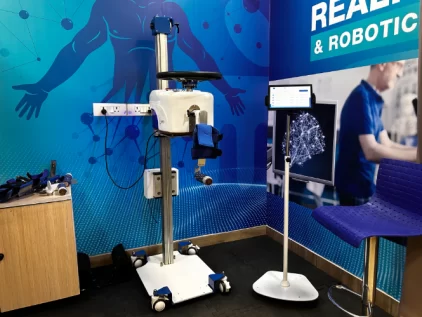WHAT WE TREAT
Ankle Sprain Rehabilitation
Best Physiotherapist in Delhi
Learn about ankle sprains, their causes, symptoms, treatment options, and prevention. Whether you’re an athlete or just want to protect your ankles, this guide has you covered.
What Is an Ankle Sprain?
An ankle sprain is an injury that occurs when the ligaments connecting the bones of the ankle joint are stretched or torn. It’s typically the result of the ankle turning or twisting beyond its normal range of motion.
Causes of Ankle Sprains
The primary cause of a sprain is the sudden or unnatural twisting of the ankle. This often happens during physical activities, such as sports, or when walking on uneven surfaces.
Risk Factors Certain factors can increase the risk of sprains, including a history of previous ankle injuries, inadequate warm-up before physical activities, and wearing improper footwear.

Symptoms
The most common symptoms of a sprain include pain, swelling, bruising, and difficulty bearing weight on the affected ankle. The severity of these symptoms may vary based on the extent of the injury.
Diagnosing Ankle Sprains
Diagnosing a sprain typically involves a physical examination by a healthcare professional. Imaging tests, such as X-rays or MRI, may be used to determine the severity and rule out fractures.
Classification
Ankle sprains are classified into three grades based on their severity: Grade I (mild), Grade II (moderate), and Grade III (severe). The grading depends on the extent of ligament damage.
Treatment and Recovery
The treatment approach for ankle sprains varies based on their severity. For mild to moderate sprains, home care, including the RICE method (Rest, Ice, Compression, Elevation), is often effective. Severe sprains may require medical intervention.
Home Care
The RICE method involves rest, icing the affected area, applying compression, and elevating the injured ankle. It’s commonly recommended for mild sprains.
Medical Treatment
Severe sprains may require medical treatment, which can include bracing or casting, physical therapy, and in some cases, surgery.
Rehabilitation and Exercises
Rehabilitation plays a critical role in the recovery of sprains. Physiotherapy is essential for improving strength, flexibility, and balance in the affected ankle.
Complications
It can lead to complications such as chronic instability, recurrent sprains, and long-term joint pain. It’s essential to address these issues promptly.
Prevention of Ankle Sprains
Preventing sprains involves maintaining ankle strength and flexibility, using appropriate footwear, and taking precautions during physical activities or sports.

Cutting-Edge Technology
Our commitment to using the best technology extends to various aspects of physiotherapy:
- Robotic Assistance: We employ robotics for gait training, aiding patients with mobility impairments. These devices facilitate improved motor control and muscle activation.
- Electrotherapy: Techniques like TENS, IFT, and Ultrasound Therapy are used to target pain relief and accelerate tissue healing.
- Virtual Reality (VR): We utilize VR and interactive gaming for engaging and enjoyable rehabilitation, increasing patient motivation and compliance with treatment.
Frequently Asked Questions
Reach out to us if you have further Questions - We're here to help!
Q1. How long does it take to recover from an ankle sprain?
Recovery time varies based on the severity of the sprain. Mild sprains may heal in a few weeks, while severe sprains can take several months.
Q2. Can I walk on a sprained ankle, or should I use crutches?
You can walk with a mild sprain, but crutches may be needed for more severe sprains to prevent further injury.
Q3. Are ankle braces or tape better for prevention during sports?
Both can be effective, and the choice may depend on personal preference and the specific sport or activity.
Q4. How can I prevent future ankle sprains if I’ve had one before?
Strengthening exercises, proper warm-up, and using supportive footwear are essential in preventing recurrent ankle sprains.
Ankle sprains are common injuries, but with the right care and rehabilitation, most people can fully recover and reduce the risk of future sprains. Proper preventive measures and seeking medical attention when needed are key to maintaining healthy ankles.
Have Questions or Need Assistance?
Don’t hesitate to reach out to us:
Book Appointment with Experts
- Call/WhatsApp: +9818911195
- Book Appointment with Experts
We are here to lend our support on your journey toward improved movement and overall well-being.
See all Blogs & Articles
See all Conditions we Treat
Note: Content provided here is for informational purposes only and is not a substitute for professional medical advice or diagnosis. If you believe you are experiencing pain or any other health-related issue, it is important to seek the advice of qualified healthcare professionals for a proper evaluation and treatment plan.


